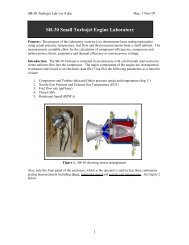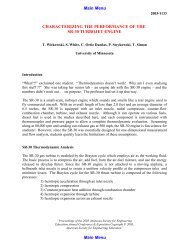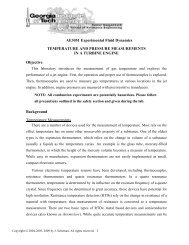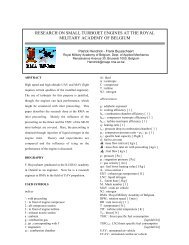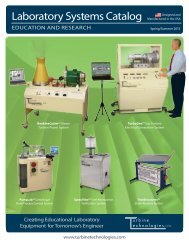Brayton Cycle Experiment – Jet Engine - Turbine Technologies
Brayton Cycle Experiment – Jet Engine - Turbine Technologies
Brayton Cycle Experiment – Jet Engine - Turbine Technologies
You also want an ePaper? Increase the reach of your titles
YUMPU automatically turns print PDFs into web optimized ePapers that Google loves.
To be more accurate, the specific heat of each fluid should be evaluated at the linear average between<br />
⎛ Tin + Tout<br />
⎞<br />
its inlet and outlet temperature, ⎜ ⎟ .<br />
⎝ 2 ⎠<br />
The irreversibilities present in the real process can be modeled by introducing the compressor<br />
efficiency,<br />
η<br />
COMP<br />
w<br />
=<br />
w<br />
C, s<br />
C, a<br />
=<br />
h<br />
h<br />
out, s<br />
out, a<br />
- h<br />
- h<br />
in<br />
in<br />
where the subscript s refers to the ideal (isentropic) process and the subscript a refers to the actual<br />
process. For a perfect gas the above equation is reduced to<br />
η<br />
COMP<br />
Combustor<br />
For the combustor,<br />
=<br />
T<br />
T<br />
out, s<br />
out, a<br />
- T<br />
- T<br />
in<br />
in<br />
Figure 3. Combustor Control Volume Model<br />
Note that ideally there is work transfer from the control volume (C.V.) to the surroundings. Under<br />
steady-state conditions, and neglecting the kinetic and potential energy effects, the first law for this<br />
control volume is then written as<br />
H�<br />
+ Q = H<br />
(7)<br />
in<br />
�<br />
in<br />
�<br />
out<br />
C.V.<br />
Combustor<br />
ó<br />
Considering that we have one flow into the control volume and one flow out of the control volume,<br />
we may write a more specific form of the first law as<br />
m� hin<br />
+ m�<br />
qC<br />
= m�<br />
hout<br />
(8)<br />
4<br />
ì<br />
(5)<br />
(6)




